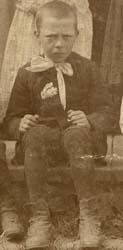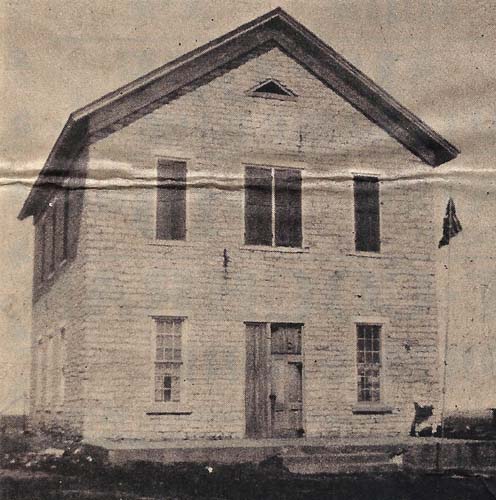updated 02/09/2013
![]()
updated 02/09/2013
Lycurgus Rock school Section 2, Makee twp. |

Lycurgus rock school, ca early 1890's
School children & adults in front of the Lycurgus rock schoolhouse about 1890. The school was between St. Mary's Catholic church, Lycurgus and the Landmark. Note that everyone in the photo is wearing flowers, including the boys; and all are dressed up. It does not seem to be a 'typical' photo of school children on a school day.

James Whalen
Above is a close-up of James Whalen, my grandfather William Whalen's older brother. In the larger photo he is the boy sitting 3rd from the left. He later became a priest of the Archdiocese of Dubuque. He died of appendicitis in Tama, Iowa on 31 Oct, 1929. His date of birth is May, 1883, so you would probably do a better job than I at figuring out how old he is. I haven't been able to determine if any of his older siblings: Daniel or Hanora 'Nora' Whalen (married Patrick McCauley) are in the photo. Hopefully someone will recognize more of the children or adults in the photo..... Matthew Whalen
~photo contributed by Matthew Whalen from his personal collection. Researchers wanting to contact Matthew can find his email address on his personal website.
~*~*~

Memories of a Rural School
by Mary PleinI am sure the stone structure known as the Lycurgus school, which has stood near Highway 9 north of Waukon at least since the early 1800’s (*sic), is remembered by a large number of people in this area. Even as long ago as that, those who built such a solid, lasting edifice certainly possessed the knowledge of carpentry and stone-masonry equal to, or superior to, that used in modern buildings, erected at the present time.
Built of solid, perfectly cut native stone, the walls of this two-story building are 20 inches thick, as well as 20 inch wide solid window sills in each of the six double windows on each floor. The two part staircase leads east up the first half-dozen or more steps, then turns right going up another eight steps leading to an entryway similar to the one on first floor, except instead of a wall separating the entryway from the woodshed under the stair steps, there is just a three foot high banister from the top of the steps to the one-time school room which hasn’t been used as a school room for more than a century. The windows have been covered with shutters at least since the beginning of the 20th century, and this area has been "off limits" to pupils attending school downstairs, the stair door being kept padlocked for safety reasons.
Beginning school there in the early 1900s, I’m sure hundreds of men and women throughout the United States got their elementary education in that great old building (usually colder inside than outdoors, this time of year). The heating apparatus, which never ceased to confuse sand amaze us as well as freeze many hands and feet, was a large wood furnace type stove which, covered with a tin jacket, stood on the floor on legs at least eight or nine inches high. If it were in a basement with a register on top, it would have been fine, but after seeming to put into it a great amount of wood, then kindling the fire, the inside part of the stove warmed up, and as warm air rises, the heat all went upward toward the ceilings at least nine or ten feet from the floor so sometimes it would be nearly the middle of the day before the room became comfortable.
You might say: "What has that got to do with the Holy Season of Christmas?" Anyhow, no matter how cold the weather was, we walked from home to school, on top of solid snowdrifts sometimes over the fence-posts, solid enough to hold our weight, when even horses pulling sleighs were unable to plow through. Sometimes there were from 30 to 42 or 45 pupils in all grades, one through eight, taught the basic subjects by one teacher, who taught an average of 10 classes daily. The ones in the grades above the third usually took six subjects daily, having to alternate geography and history — reading and spelling, or civics and music.
But about this time of year excitement ran high, scissors were brought out, and every spare moment was spent cutting red and green crepe, tissue, or construction paper into bells, trees, stars etc., stringing popcorn, hooking up tinsel or homemade angels, candy canes or whatever, to place upon a tree, dragged from a nearby woods by some of the bigger boys. But most important of all was writing names on small slips of paper, drawing each other’s names for gift exchange, one gift per pupil. Usually the teacher gave each of us an orange or a popcorn ball either of which we looked forward to eagerly. However, before Santa appeared with his sack of candy or gifts, there would be a Christmas program. This was one of the highlights of our young lives to get up before our parents, recite a poem, learn the lines of a Christmas dialogue, acting out the parts, then interspersing these with the old songs, Silent Night, Come All Ye Faithful and later years, Rudolph The Red- Nosed Reindeer, and Santa Claus Is Coming To Town. These programs were usually given in the afternoon, or if in the evening, there had to be kerosene lamps lighted, wires strung with bed sheets for curtains to be pulled shut between performances.
After the Christmas program came our glorious two week’s vacation! But usually all the country people attended church, perhaps early on Christmas Eve night at Churchtown Congregational church, then with team and bobsled to St. Mary’s, Lycurgus, for midnight mass, a beautiful ceremony, but after midnight mass oyster stew, presents from Santa Claus, then Christmas dinner. Hopefully a big snowstorm during vacation delayed the opening of school, but I’m sure if that great old building could speak, many happy events could be recorded for posterity.
My mother taught that school, seven years, 1900 to 1907. I taught three years, 1934 to 1937. My sister taught there two years. Four generations of my family attended that school. It is now remodeled into a dwelling but how great it would be at some time to have a reunion of all whose shadows darkened the doorway of that school house, which still and will continue to stand by the "side of the road" for many, many years. It certainly has been the scene of many Christmas Programs in days gone by, and customs changing each year. Season’s Greetings to all who were lucky enough to roast, freeze, study, smile, cry, become friends and keep happy memories together over the years, and eternal rest to those good Lycurgus friends no longer with us. Special greetings to Gertrude Laughlin, the same gal today she was the first day I entered, that building and for four of my seven years as a pupil.
~Republican-Standard, Waukon, IA, December 18, 1979
~contributed by Errin Wilker*That the school was built in the "early 1800's" is an exaggeration
~*~*~